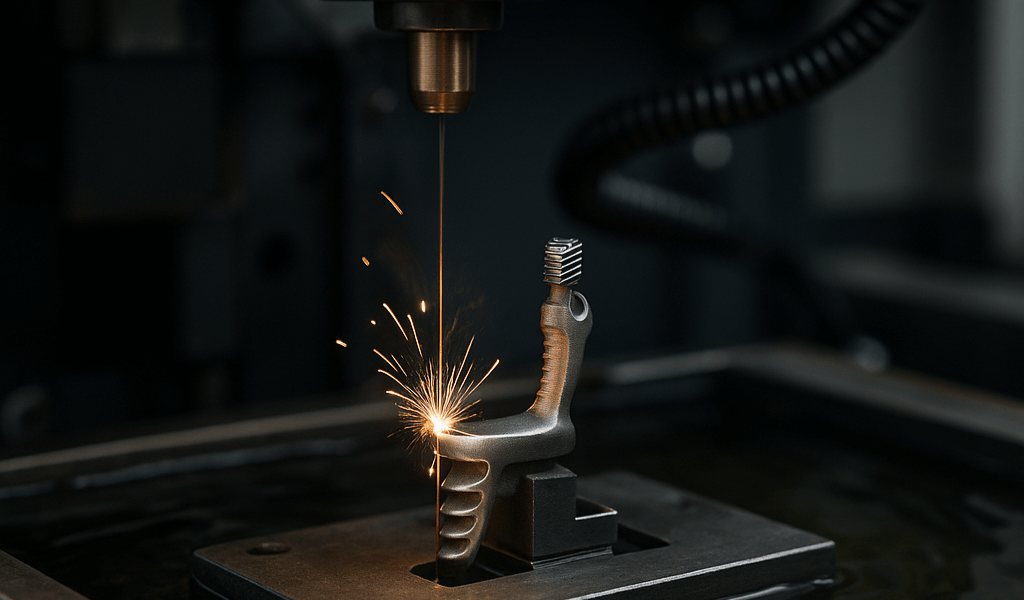
Precision plays a central role in modern medical technology. Whether surgical instruments, implants or highly complex components – the requirements for dimensional accuracy and material properties are enormous. This is where EDM machines come into play, offering invaluable benefits with their unique ability to machine conductive materials with the utmost precision.
But why EDM machines in particular? And how exactly do they help to meet the strict requirements of medical technology? In this article, we take a deep dive into the world of EDM technology, explain its areas of application, shed light on the challenges and highlight the potential that can still be expected in the future.
By the end, you will not only understand why EDM is a key technology for medical technology, but also how you can benefit from this innovative manufacturing technology. Stay tuned – it’s worth it!
- EDM machines offer maximum precision for medical components.
- Wire EDM for filigree cuts, die-sinking EDM for complex shapes.
- Processing of biocompatible materials such as titanium and stainless steel.
- ISO 9001 and ISO 13485 certification guarantees quality.
- Progress through automation and the use of AI for process optimization.
- Retero GmbH: Your partner for precise and innovative medical technology solutions.
Table of contents
What are EDM machines and why are they indispensable in medical technology?
Functional principle of EDM machines
Electrical discharge and precision – this combination characterizes the EDM machines. EDM stands for Electrical Discharge Machining and is based on a fascinating physical principle: material is removed by electrical spark discharges. This means that a high voltage is applied between the electrode and the workpiece, which leads to material removal through the ignition of a spark. The decisive factor here is that the machining process is contactless, which avoids mechanical deformation and stresses in the workpiece.
In practice, there are two main processes: Die-sinking EDM and wire EDM. In die-sinking EDM, a solid electrode is used to imprint the desired shape directly into the material. This process is typically used to create
Another important process is start hole erosion, which serves as preparation for wire erosion. Here, small holes with diameters from 0.1 mm are made in order to insert the wire for the actual erosion. This combination of different erosion processes enables incredible versatility in component machining.
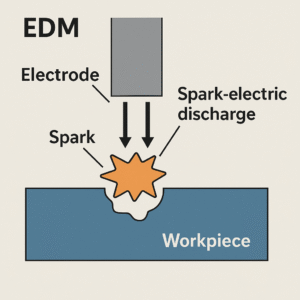
Why EDM in medical technology?
Medical technology places the highest demands on precision and material quality. Errors are not only undesirable, they are simply unacceptable. EDM machines are the first choice when it comes to processing implants and surgical instruments. Why? Quite simply because they offer a combination of high precision, gentle material processing and the ability to reliably shape even the most complex geometries.
While conventional processes such as milling or turning often reach their limits – whether due to hard materials or delicate structures – EDM technology remains unimpressed. EDM processes conductive materials such as titanium and stainless steel without contact, so that even minimal deformation is avoided.
Another advantage is flexibility. Even with biocompatible materials, which are necessary for implants, fine surface qualities and the smallest tolerances can be achieved. This is particularly important for dental implants, where a perfect fit is crucial to the success of the treatment. EDM also enables the machining of special surgical instruments that require complex cuts and precise contours.
If you compare EDM with other processes, it becomes clear: The high precision and the ability to process hard materials make EDM indispensable. Especially in the field of patient-specific implants, it is clear that EDM plays a central role. This is because only this technology makes it possible to produce individual geometries that are precisely adapted to the anatomical conditions.
Typical applications in medical technology
EDM machines can be used for a wide range of applications in medical technology. One particularly common area of application is the manufacture of dental implants. Here, the implants not only have to be precisely manufactured, but also made of biocompatible materials such as titanium or stainless steel. Spark erosion ensures that even the smallest deviations are avoided – a key prerequisite for medical success.
EDM machines are also used for surgical instruments. Scalpel holders, microsurgical tools and high-precision ophthalmology instruments are just a few examples. Thanks to contact-free machining, the surface remains flawless, which optimally meets hygiene requirements.
Another field is the production of patient-specific implants. These individually adapted components often require complex geometries that are almost impossible to achieve using conventional methods. Even intricate structures can be reliably formed using wire EDM.
Applications in the field of micromechanics are particularly demanding. Here, fine structures and the smallest bores must be produced with a precise fit, which makes micro EDM the method of choice. Typical workpieces here are micro nozzles, spinnerets and implants with micro channels.
To summarize: EDM machines open up unimagined possibilities in medical technology. Their ability to precisely machine hard and biocompatible materials makes them an indispensable tool for manufacturers of implants and surgical instruments.
Precision and material compatibility: the strengths of EDM machines

Precision in the sub-micrometer range
In medical technology, dimensional accuracy and precision are decisive quality features. EDM machines set standards here, particularly through the use of CNC-controlled systems. These high-precision machines enable machining in the sub-micrometer range, which in practice means tolerances of a few thousandths of a millimetre.
Why is this precision so important? Surgical instruments and medical implants must not only fit perfectly, but also be stable and durable. Even the smallest deviations can significantly affect the functionality and service life of an implant. EDM machines make it possible to maintain extremely tight tolerances. Precise control of the electrical discharge allows intricate contours and complex geometries to be reliably realized.
A key advantage of EDM technology is contactless machining. In contrast to mechanical processes, there is no pressure on the workpiece, which prevents deformation. At the same time, the surface quality remains unaffected as no tool touches the workpiece surface directly. This results in smooth and fine surfaces that can be reworked without changing the structure.
Material variety and customization
Another advantage of EDM machines is their ability to process a wide range of conductive materials. Titanium and stainless steel are particularly in demand in the field of medical technology. These materials not only offer the necessary biocompatibility, but also the required stability and corrosion resistance.
Titanium is known for its strength and corrosion resistance, which makes it ideal for implants and orthopaedic devices. However, it is the machining in particular that presents a challenge. Conventional milling processes often reach their limits, as the material wears down the tools considerably. EDM machines elegantly circumvent this problem: contact-free machining means that neither tool wear nor thermal stresses occur.
Stainless steel, another key material in medical technology, also requires precise machining. Smooth, hygienic surfaces are essential, especially for surgical instruments. EDM technology makes it possible to produce these surfaces without mechanical action, which minimizes the risk of surface defects.
In addition to titanium and stainless steel, cobalt-chrome alloys, copper and graphite can also be processed efficiently. Thanks to the adaptability of the machine parameters to the respective material, EDM technology guarantees optimum processing quality.
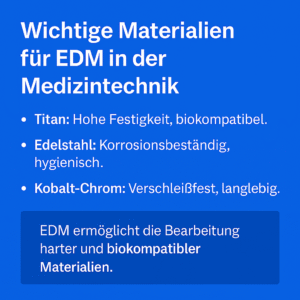
Typical problems and solutions
Despite their advantages, EDM machines can also present challenges. One common issue is the surface quality after EDM. During
Another problem is the thermal effects during the machining process. As machining is based on spark discharge, localized heating can occur. If these temperatures are not controlled, the material structure can be impaired. Modern EDM systems are therefore equipped with cooling systems that efficiently dissipate the heat and prevent the build-up of thermal stresses.
The selection of the right dielectric also plays a decisive role. The use of specialized fluids can improve discharge control and reduce material stress. This ensures that the surface produced meets medical standards and that no additional processing steps are necessary.
Another aspect is repeat accuracy. As medical components are often manufactured in series, consistent quality is essential. CNC-controlled EDM machines offer the possibility of producing identical components with minimal tolerance deviations.
Processes and techniques: Which EDM machines are used?
Wire EDM: Precise cuts for filigree components
Wire EDM is one of the most versatile processes in the field of EDM technology. In this method, a fine, electrically charged wire is passed through the workpiece. During this process, electrical sparks are created between the wire and the material, enabling precise material removal. The result: wafer-thin cutting widths and filigree structures that would be almost impossible to achieve with other processes.
A key advantage of wire EDM is the ability to produce extremely fine contours and complex geometries. This is particularly important for precision surgical instruments, as a high degree of accuracy is required. The ability to machine without contact also plays a key role for micro parts in medical technology. Due to the lack of mechanical influence, the surface quality remains consistently high without the risk of deformation.
Typical applications include the manufacture of scalpel holders, micro-cutting tools and precision mechanical components that require extremely precise cuts. Even with extremely hard materials such as titanium or stainless steel, wire EDM offers impressive accuracy. This is particularly relevant in the production of medical implants, where any deviation in geometry could compromise functionality.
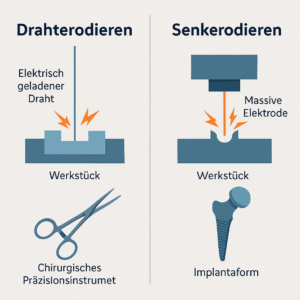
Die sinking: Complex shapes and deep contours
When it comes to machining three-dimensional structures, die-sinking EDM offers unbeatable advantages. Unlike wire erosion, this process uses a solid electrode that imprints the desired shape directly into the material. This is achieved by targeted spark discharges that remove small particles from the workpiece.
A common area of application for die-sinking EDM is mold making for implants. The strength of this method is particularly evident in complex 3D geometries and deep incisions. The precise control of the erosion parameters ensures that even deep cavities can be produced with minimal tolerances. This is particularly important for orthopaedic implants, which often have complicated shapes and precise fits.
In addition, die-sinking EDM enables the machining of conductive materials with high strength. This means that even alloys containing hard metals or corrosion-resistant materials can be machined without any problems. Another advantage is the low heat development during the process. As a result, no structural changes occur in the material, which ensures the durability and stability of the manufactured components.

Start hole erosion: Preparation for wire erosion
In order to carry out wire erosion effectively, a precise starting hole is often required. This is where
This technology is particularly indispensable in medical technology. Typical applications include the machining of small medical parts that require micro-drilling. One example is the manufacture of microfluidic components or endoscopes, where drilling is a prerequisite for precise wire erosion.
The advantages of start hole erosion lie in the ability to produce a precise hole geometry even with hard materials. The process is fully automated and is therefore ideal for the series production of medical components. As the start holes can be positioned precisely, a high level of process reliability is guaranteed, which is essential in medical technology.
To summarize: Wire EDM, die-sinking EDM and start-hole EDM complement each other perfectly in modern medical technology. Their ability to produce complex and precise components makes them indispensable tools in the manufacture of surgical instruments, implants and other medical components.
Challenges and concerns when using EDM in medical technology
High investment costs and cost-effectiveness
The purchase of an EDM machine often represents a considerable financial burden. Investment costs are a key challenge, especially for smaller manufacturers in the medical technology sector. High-quality machines not only require a considerable purchase price, but also ongoing maintenance costs and regular staff training. When is this investment still worthwhile?
The decisive factor is the planned area of application. Companies that regularly need to produce high-quality precision parts benefit from having their own EDM machine in the long term. Especially for custom-made products and patient-specific implants, in-house production is often more cost-effective than outsourcing. In addition, modern machines offer high repeat accuracy, which is particularly important for series production.
However, for smaller manufacturers who only occasionally need EDM processing, the purchase is rarely worthwhile. In such cases, working with specialized service providers is a more economical alternative. External providers have state-of-the-art machines and extensive process experience. Outsourcing allows the production of individual items or small batches to be handled cost-effectively without burdening the company’s own infrastructure.
A cost-benefit analysis should therefore always be carried out at the start of any investment decision. Factors such as production volume, quality requirements and the desired flexibility should be carefully weighed up.
Production speed and quantities
Although EDM machines are unsurpassed in terms of precision, there are certain limitations in terms of production speed. The process is comparatively time-consuming, as machining is carried out step-by-step using electrical discharge machining. This can be a problem, especially with large quantities.
Efficient process design is therefore essential for the series production of medical products. Many manufacturers rely on automated CNC systems for this. The combination of automation and EDM technology enables significantly higher processing speeds to be achieved. Machines with multiple clamping systems make it possible to process several components simultaneously, which significantly increases productivity.
The use of CAD/CAM software can also optimize production processes. The automatic creation of machining plans and integration into existing production lines minimizes set-up times and shortens throughput times.
Nevertheless, the question remains: Is EDM the right choice for every series production? In cases where mass production and high speed are required, conventional machining processes often offer advantages. The decision therefore depends heavily on the complexity and quality requirements of the product in question.
Quality requirements and regulations
Strict quality standards apply in medical technology. Manufacturers must ensure that their products meet the highest standards of safety and precision. Compliance with the ISO 9001 and ISO 13485 standards plays a key role here. These certifications confirm that production is carried out in accordance with defined quality management systems and that processes are documented in a traceable manner at all times.
In order to meet these requirements, consistent quality assurance is essential. The process parameters must be continuously monitored and documented during EDM processing. This allows sources of error to be identified and rectified at an early stage.
Another quality feature is the inspection of the finished components. A microscopic inspection is often carried out to detect even the smallest surface defects. The creation of measurement logs is also a standard measure to document compliance with the required tolerances.
The validation of the machines used is particularly critical. Regular maintenance and calibration are necessary to ensure the consistent quality of the components produced. This applies in particular to the repeatability and stability of the machining processes.
To summarize: the combination of investment costs, production speed and strict quality requirements places high demands on EDM technology. Nevertheless, it remains an indispensable method for the production of high-precision medical components, especially when precise fits and long-lasting material quality are required.
Best practices: How companies successfully integrate EDM
Planning and implementation
The successful integration of EDM machines begins with sound planning. A careful analysis of the application area is crucial in order to select the appropriate machines. The component complexity, the desired material variety and the targeted production quantity play a central role.
Not every EDM machine is equally suitable for all applications. While wire EDM is ideal for fine contours and filigree structures, die-sinking EDM offers advantages for complex 3D geometries. The selection should therefore be specifically tailored to the requirements of medical technology.
Comprehensive advice from experts is also advisable. Specialists can not only provide support in the selection of machines, but also provide valuable assistance in the planning of production processes. This allows investment risks to be minimized and the machines to be optimally integrated into existing production processes.
It also makes sense to plan the implementation in several phases. After an initial test phase, the machines should be gradually transferred to series production. This allows potential problems to be identified and rectified at an early stage.
Cooperation with experienced partners
In many cases, working with specialized service providers is an effective way of keeping costs under control. Smaller companies in particular can benefit from this strategy. Outsourcing certain manufacturing processes eliminates the need to purchase expensive machinery. In addition, companies can concentrate on their core competencies, while the processing of complex components is placed in the hands of professionals.
Experienced EDM providers have modern machine technology and the necessary expertise to handle complex projects efficiently. These partners can often produce faster and more cost-effectively as they have optimized process chains. Flexibility in small series or prototype production is also a major advantage.
A long-term partnership also offers additional benefits. In addition to pure production, specialized service providers can also offer consulting services, for example in selecting the appropriate EDM process or optimizing the manufacturing strategy. This not only saves the company time and money, but also allows it to concentrate on developing innovative products.
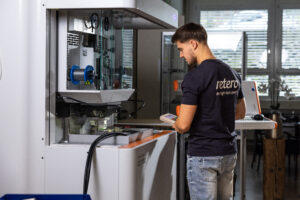
Future prospects: How is EDM technology developing?
Progress in automation
The future of EDM technology is closely linked to advancing automation. More and more companies are turning to smart manufacturing to make production more efficient and flexible. AI-supported systems play a central role in this. These intelligent solutions enable precise process monitoring and autonomous error correction during machining.
By integrating AI into EDM machines, machining times can be shortened and process reliability increased. Systems detect anomalies in real time and automatically adjust the erosion parameters to ensure the desired surface quality. This not only reduces the reject rate, but also the need for manual intervention.
Another advantage lies in data analysis. Modern machines record extensive process data during production, which is analyzed using artificial intelligence. This provides valuable insights into production quality and possible optimization potential. These findings help to continuously improve the process chains.
Such developments are particularly beneficial in medical technology. As the requirements for precision and repeatability are high, automated processes contribute to consistent product quality. At the same time, efficiency is increased, making the production of small batches more economical.
Sustainability and energy efficiency
Another important trend in EDM technology is the improvement of sustainability. In view of rising energy prices and growing ecological responsibility, the focus is shifting to energy-efficient machines. Modern systems consume up to 30% less energy thanks to optimized spark generation and the use of innovative dielectrics.
In addition, manufacturers are increasingly focusing on the reuse of electrodes. While worn electrodes were often replaced in the past, new recycling processes enable them to be reprocessed. This not only reduces material consumption, but also significantly reduces the amount of waste.
The minimization of cooling liquids also contributes to environmental friendliness. The use of water-based dielectrics reduces the use of oil, which lowers disposal costs and reduces the environmental impact. In addition, new machines work with closed cooling systems that allow the fluids to be reused.
These developments show that EDM technology is increasingly becoming a sustainable manufacturing process. Companies benefit from lower operating costs and improve their ecological footprint at the same time.
New material developments
As materials science advances, the possibilities of EDM technology are also expanding. Biocompatible and wear-resistant materials are particularly in demand in medical technology. However, new alloys and ceramic-based materials place increased demands on machining technology.
One exciting development is the processing of bioactive metals such as titanium alloys with EDM machines. These materials are ideal for medical implants as they are characterized by a high level of body compatibility. However, machining requires special parameters in order not to damage the sensitive surface structure.
The processing of ceramic materials is also evolving. Ceramics used to be considered difficult to erode, but new machines with adapted discharge maps now enable precise material removal. This opens up new possibilities in the production of surgical tools and implants with wear-resistant surfaces.
Another innovative step is the development of conductive plastics that can be processed using electrical discharge machining. These materials combine the advantages of lightweight construction with the durability of metallic components. Applications are mainly found in medical devices that need to combine electrical conductivity and low weight.
With these developments, EDM technology will remain a central component of medical technology in the future. New materials and innovative machining processes are helping to make production even more precise and efficient.
Why choosing the right partner is crucial
Expertise and experience
The successful implementation of EDM projects requires not only state-of-the-art machine technology, but above all sound specialist knowledge. Experience plays a decisive role here. Companies that specialize in the machining of high-precision medical components have the necessary expertise to reliably implement even the most demanding geometries.
Not every workshop can meet the high demands of medical technology. Especially when it comes to patient-specific implants or complex surgical instruments, it is essential to rely on a partner with extensive project experience. Faulty components or inconsistent surface quality can have considerable consequences.
An experienced EDM service provider not only offers technical expertise, but also comprehensive advice. Right from the planning stage, experts help to select the right machining strategies and optimize production processes. The combination of specialist knowledge and state-of-the-art machine technology means that sources of error can be avoided and the desired precision reliably achieved.
Quality management and certifications
Compliance with quality standards is essential in medical technology. Products must meet the highest safety requirements to ensure their use in critical medical applications. ISO 9001 and ISO 13485 certifications play a key role here.
ISO 9001 certification confirms that a company has implemented a comprehensive quality management system. It ensures that the processes are comprehensibly documented and regularly reviewed. This transparency creates trust among customers and partners.
Even more specific to medical technology is ISO 13485, which certifies that all production steps meet the special requirements for medical products. From the raw material to the final inspection, it ensures that the manufactured components comply with the strict regulations.
Companies like Retero GmbH attach particular importance to seamless quality assurance. Thanks to the combination of certified processes and precise EDM procedures, even the most complex medical technology projects can be realized safely. This reliability gives customers the certainty that they will always receive consistently high product quality.
Innovative strength and individualization
Another decisive factor when choosing the right partner is innovative strength. While many providers offer standardized solutions, specialized companies such as Retero GmbH rely on tailor-made production strategies. In medical technology in particular, the ability to customize is a real competitive advantage.
Whether implants with complex geometries or special surgical tools – production requirements vary greatly. Retero GmbH has a wide range of machinery at its disposal, which enables flexible adaptation to customer requirements. By combining different EDM processes, even demanding projects can be implemented efficiently.
Retero GmbH is also actively driving forward the further development of EDM technology. By using the latest machines and training employees, production processes are always kept up to date. This willingness to innovate ensures that customers have access to the latest production technologies and at the same time offers the opportunity to receive customized solutions.
In practice, this means Instead of rigid standards, Retero GmbH offers individual processing concepts – precisely tailored to the specific requirements of the project. This combination of expertise, certification and flexibility makes the difference and guarantees optimum implementation of your EDM projects.
Let us realize your ideas together - contact Retero GmbH and benefit from our experience and our commitment to precision and quality.
Conclusion: Precision and reliability for medical technology
EDM technology has established itself as an indispensable part of modern medical technology. Its outstanding ability to produce complex geometries with maximum precision and repeatability makes it the first choice for the manufacture of implants, surgical instruments and other medical components.
In particular, the combination of material diversity, innovative machinery and the ability to process even the most challenging materials offers a decisive advantage. Whether titanium, stainless steel or newly developed bioactive materials – the flexibility of the EDM machines ensures that future requirements can also be mastered without any problems.
Another success factor is the continuous development of technology. The use of AI and automation not only makes processes more efficient, but also more sustainable. This innovative strength ensures competitiveness and makes EDM technology a key component in the field of medical technology in the future too.
Choosing the right partner is crucial to making the most of the benefits. Specialized companies such as Retero GmbH not only offer state-of-the-art machines, but also comprehensive expertise and practical solutions. By combining experience, certification and flexibility, customers receive tailor-made production concepts that meet the highest quality standards.
EDM technology will continue to play a central role in the production of precision medical parts in the future. Its ability to process biocompatible materials and its continuous development make it an indispensable tool in an industry that depends on reliability and innovation.
